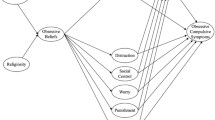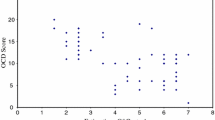Abstract
Within the field of psychology of religion there has been increasing interest to test established theoretical perspectives with empirical data. One such initiative is concerned with examining theories derived from Freud and has examined the relationship between religiosity and obsessionality. This initiative has become increasingly complex, using a variety of different measures of both religiosity (attitude, practice and orientation) and obsessionality (personality traits and symptoms). The findings can be summarized: More positive religious attitude and greater frequency of religious practice are associated with higher scores on measures of obsessional personality traits, but not with scores on a measure of obsessional symptoms. Further, the limited data on the relationship between religious orientation and obsessionality is contradictory.
Similar content being viewed by others
References
Allport, G.W., and Ross, J.M. (1967), “Personal Religious Orientation and Prejudice.” Journal of Personality and Social Psychology 5, pp. 432–443.
Batson, C.D., and Ventis, W.L. (1982), The Religious Experience: A social-psychological perspective. New York: Oxford University Press.
Bergin, A.E. (1983), “Religiosity and Mental Health: A Critical Revaluation and Meta-analysis.” Professional Psychology: Research and Practice, 14 pp. 170–184.
Centers, R. (1969), “The Anal Character and Social Severity in Attitudes.” Journal of Projective Techniques and Personality Assessment 33, pp. 501–506.
Chamberlain, K., and Zika, S. (1992), “Religiosity, Meaning in Life, and Psychological Well-being.” In J.F. Schumaker, ed., Religion and Mental Health New York: Oxford University Press, pp. 138–148.
Delay, J., Pichot, P., and Perse, J. (1962), “Personnalité obsessionelle et caractère dir obsessionel: étude clinique et psychometrique.” Revue Psychologie Applique 12, pp. 233–62.
Donahue, M.J. (1985), “Intrinsic and Extrinsic Religiousness: Review and meta-analysis.” Journal of Personality and Social Psychology 48, pp. 400–419.
Farber, M.L. (1955), “The Anal Character and Political Aggression.” Journal of Abnormal and Social Psychology 51, pp. 486–489.
Fontana, D. (1980). “Some Standardization Data for the Sandler-Hazari Obsessionality Inventory.” British Journal of Medical Psychology 53, pp. 267–275.
Francis, L.J. (1993), “Reliability and Validity of a Short Scale of Attitude Towards Christianity among Adults.” Psychological Reports 72, pp. 615–618.
Francis, L.J. and Stubbs, M.T. (1987), “Measuring Attitudes towards Christianity: From Childhood to Adulthood.” Personality and Individual Differences 8, pp. 741–743.
Freud, S. (1908). “Character and Anal Eroticism.” In J. Strachey, ed. and trans., The standard edition of the complete psychological works of Sigmund Freud London: Hogarth Press, (Vol. 9, pp. 167–175).
Freud, S. (1924). “A Short Account of Psychoanalysis.” Standard Edition London: Hogarth Press, (Vol. 19, pp. 189–209).
Freud, S. (1953). Totem and Taboo. Standard Edition. London: Hogarth Press, (Vol. 13, pp. 1–161).
Freud, S. (1959). “Obsessive Acts and Religious Practices.” Standard Edition. London: Hogarth Press, (Vol. 9, pp. 115–127).
Freud, S. (1961), The Future of an Illusion. Standard Edition. London, Hogarth Press, Vol. 21, pp. 1–56.
Gorsuch, R.L. (1988), “Psychology of Religion.” Annual Review of Psychology pp. 201–221.
Gorsuch, R.L. and Venable, G.D. (1983), “Development of an Age Universal I-E scale.” Journal for the Scientific Study of Religion 22, pp. 181–187.
Juni, S. and Fischer, R.E. (1985), “Religiosity and Preoedipal Fixation,” Journal of Genetic Psychology, 146, pp. 27–35.
Kaldestad, E. (1992), “Religious Orientation, Personality, Mental Health, and Religious Activity, Nordic Journal of Psychiatry 46, pp. 321–328.
Kaldestad, E. (1993), Letter to the Editor. Nordic Journal of Psychiatry 47, pp. 307–308.
Kaldestad, E. (1995), “The Empirical Relationship of the Religious Orientations to Personality.” Scandinavian Journal of Psychology 36, pp. 95–108.
Kaldestad, E. (1996), “The Empirical Relationships between Standardized Measures of Religiosity and Personality/Mental health.” Scandinavian Journal of Psychology 37, pp. 205–220.
Kaldestad, E. and Stifoss-Hanssen, H. (1993), “Standardizing Measures of Religiosity for Norwegians,” The International Journal for the Psychology of Religion 3, pp. 111–124.
Kay, W.K., and Francis, L.J. (1996), Drift from the Churches: Attitude toward Christianity during childhood and adolescence. Cardiff: University of Wales Press.
Kline, P. (1969), “The Anal Character: A Cross-cultural Study in Ghana.” British Journal of Social and Clinical Psychology 8, pp. 201–210.
Kline, P. (1971), Ai3Q: An experimental manual. Windsor: National Foundation for Educational Research.
Kline, P. (1981), Fact and Fantasy in Freudian Theory (2nd edition). London: Methuen.
Lea, G. (1982), “Religion, Mental Health, and Clinical Issues.” Journal of Religion and Health 21, pp. 336–351.
Lewis, C.A. (1994), “Religiosity and Obsessionality: The Relationship between Freud's 'Religious Practices.'” Journal of Psychology 128, pp. 189–196.
Lewis, C.A. (1996), “Religiosity and Obsessionality.” In L. J. Francis, W.K. Kay, and Cambell, W.S. eds., Research in Religious Education Herefordshire: Gracewing, pp. 219–227.
Lewis, C.A. and Joseph, S. (1994a), “Religiosity: Psychoticism and Obsessionality in Northern Irish University Students.” Personality and Individual Differences 17, pp. 685–687.
Lewis, C.A. and Joseph, S. (1994b), “Obsessive Actions and Religious Practices.” Journal of Psychology 128, pp. 699–700.
Lewis, C.A. and Maltby, J. (1992), “Religiosity and Preoedipal Fixation: A Refinement.” Journal of Psychology 126, pp. 687–688.
Lewis, C.A. and Maltby, J. (1994), “Religious Attitudes and Obsessional Personality Traits among UK Adults.” Psychological Reports 75, pp. 353–354.
Lewis, C.A. and Maltby, J. (1995), “Religious Attitude and Practice: The Relationship with Obsessionality.” Personality and Individual Differences 19. pp. 105–108.
Maltby, J., McCollam, P., and Millar, D. (1994), “Religiosity and Obsessionality: A Refinement.” Journal of Psychology 128, pp. 609–611.
Maltby, J., Talley, M., Cooper, C., and Leslie, J.C. (1995), “Personality Effects in Personal and Public Orientations Toward Religion.” Personality and Individual Differences 19, pp. 157–163.
Masling, J., Rabie, L., and Blondheim, S.H. (1967), “Obesity, Level of Aspiration, and Rorschach and TAT Measures of Oral Dependence.” Journal of Consulting Psychology 31, pp. 233–239.
Rabinowitz, W. (1957). “Anality, Aggression, and Acquiescence.” Journal of Abnormal and Social Psychology 54, pp. 140–142.
Sandler, J., and Hazari, A. (1960), “The Obsessional: On the Psychological Classification of Obsessional Character Traits and Symptoms. British Journal of Medical Psychology 33, pp. 113–122.
Sanau, V.D. (1969), “Religion, Mental Health, and Personality: A Review of Empirical Studies.” American Journal of Psychiatry 125, pp. 97–107.
Schumaker, J.F., Religion and Mental Health. New York: Oxford University Press.
Spilka, B., Hood, R.W. Jr., and Gorsuch, R.L. (1985), The Psychology of Religion: An Empirical Approach. Englewood Cliffs, N.J.: Prentice Hall.
Stark, R. (1971), “Psychopathology and Religious Commitment.” Review of Religious Research 12, pp. 165–176.
Torgersen, S. (1980), “Heredity Environmental Differentiation of General Neurotic, Obsessive and Impulsive Hysterical Traits.” Acta Genetica Medicae et Gemellologiae 29, pp. 193–207.
Trijsburg, R.W., and Duivenvoorden, H.J. (1987), “Reactive-Narcissistic Character, Obsessional Personality and Obsessive-Compulsive Behaviour: A Study of the Validity of Sandler and Hazari's Typology.” British Journal of Medical Psychology 60, pp. 271–278.
Ventis, W. L. (1995), “The Relationships between Religion and Mental Health.” Journal of Social Issues 51, pp. 33–48.
Witter, R.A, Stock, W.A., Okun, M.A., and Haring, M.J. (1985), “Religion and Subjective Well-being in Adulthood: A Quantitative Synthesis.” Review of Religious Research 26, pp. 332–342.
Wulff, D.M. (1991), Psychology of Religion: Classic and Contemporary Views. Chichester: John Wiley and Sons.
Rights and permissions
About this article
Cite this article
Lewis, C.A. Cleanliness Is Next to Godliness: Religiosity and Obsessiveness. Journal of Religion and Health 37, 49–62 (1998). https://doi.org/10.1023/A:1022913117655
Issue Date:
DOI: https://doi.org/10.1023/A:1022913117655




